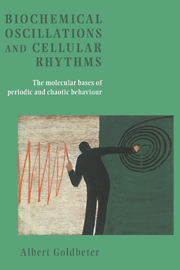Book contents
- Frontmatter
- Contents
- Foreword to the English edition by Michael Berridge
- Foreword to the French edition by Ilya Prigogin
- Preface
- 1 Introduction
- Part I Glycolytic oscillations
- 2 Oscillatory enzymes: simple periodic behaviour in an allosteric model for glycolytic oscillations
- Part II From simple to complex oscillatory behaviour
- Part III Oscillations of cAMP in Dictyostelium cells
- Part IV From cAMP signalling in Dictyostelium to pulsatile hormone secretion
- Part V Calcium oscillations
- Part VI The mitotic oscillator
- Part VII Circadian rhythms
- References
- Index
2 - Oscillatory enzymes: simple periodic behaviour in an allosteric model for glycolytic oscillations
Published online by Cambridge University Press: 26 February 2010
- Frontmatter
- Contents
- Foreword to the English edition by Michael Berridge
- Foreword to the French edition by Ilya Prigogin
- Preface
- 1 Introduction
- Part I Glycolytic oscillations
- 2 Oscillatory enzymes: simple periodic behaviour in an allosteric model for glycolytic oscillations
- Part II From simple to complex oscillatory behaviour
- Part III Oscillations of cAMP in Dictyostelium cells
- Part IV From cAMP signalling in Dictyostelium to pulsatile hormone secretion
- Part V Calcium oscillations
- Part VI The mitotic oscillator
- Part VII Circadian rhythms
- References
- Index
Summary
Experimental observations on glycolytic oscillations
Glycolytic oscillations are the prototype for periodic phenomena in biochemistry, even if the function of these oscillations, if there is any, has for long remained obscure. Their study began some 30 years ago, and still continues. The first observation indicating the existence of oscillatory behaviour in glycolysis is due to Duysens & Amesz (1957), who reported, by studying the fluorescence of some glycolytic intermediates in yeast, that one of these underwent damped oscillations in the course of time (fig. 2.1).
This observation was pursued from 1964 on by Chance and coworkers (Chance, Schoener & Elsaesser, 1964; Ghosh & Chance, 1964; Pye & Chance, 1966), who showed that glycolytic oscillations could be maintained in yeast suspensions for relatively long periods of time. Quickly thereafter observations were conducted on yeast extracts, with very similar results. Regular oscillations were recorded over an extended period of time, provided that the glycolytic substrate was produced in a continuous manner (Chance, Hess & Betz, 1964; Hess, Brand & Pye, 1966; Pye & Chance, 1966; Pye, 1969, 1971). The latter condition was fulfilled when trehalose was used, this metabolite being transformed into a glycolytic substrate by the enzyme trehalase at a low, constant rate (fig. 2.2). The periodic phenomenon is also observed in a single yeast cell (Chance, Pye & Higgins, 1967). All glycolytic intermediates oscillate with the same frequency (fig. 2.3), but with different phases (Betz & Chance, 1965).
- Type
- Chapter
- Information
- Biochemical Oscillations and Cellular RhythmsThe Molecular Bases of Periodic and Chaotic Behaviour, pp. 31 - 88Publisher: Cambridge University PressPrint publication year: 1996
- 3
- Cited by



